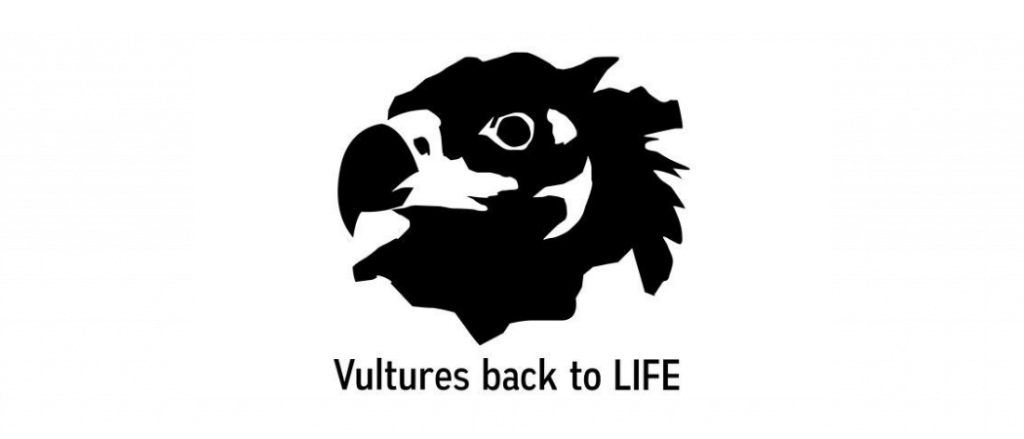
Following many years of targeted and collaborative conservation actions, the Cinereous Vulture returned as a breeding species in Bulgaria this year. What marked this historic milestone was the successful hatching of a chick in the wild by the reintroduced pair Balkan and Kamchya. The Vultures Back to LIFE team closely monitored the situation from the start, witnessing first-hand the smooth evolution of the young vulture. Last week, the vulture finally reached the appropriate age to enable the project team to fit it with rings and a GPS transmitter, which will in turn help follow its progress in the wild and rescue the bird if it needs assistance.
Tagging the young Cinereous Vulture in the nest
Meet Mitchev-Boev – the first juvenile Cinereous Vulture that hatched in Bulgaria in the last 28 years and the first in the Balkan Mountains for more than 60 years. At the end of July 2021, the Vultures Back to LIFE project team hiked to a remote area to access the nest that hosts Mitchev-Boev. The field team had to climb the tree to reach the nest situated at the treetop and carefully retrieve the nestling. Once the experts on the ground got a hold of the vulture, they ringed it with a standard ornithological and colour plastic ring, as well as tagged it with a GPS transmitter to follow its whereabouts after fledging. The vulture was 78 days old and weighed 5.6 kg.
It is named after the Bulgarian ornithologists and nature conservationists Tanyo Mitchev and Nikolay Boev, who were the first to publish an article proposing the reintroduction of the species in the country back in 1980, tens of years after the species was considered locally extinct. This article and the authors themselves inspired most of the current conservationists working for vulture conservation in Bulgaria and the ones that initiated and implemented the reintroduction of the Cinereous Vulture in the Balkan Mountains.
The comeback of the Cinereous Vulture in Bulgaria
In 2021, the project team discovered four Cinereous Vulture nests – three in Eastern Balkan Mountain (one more just recently discovered) and one in Vrachanski Balkan in Bulgaria. This outcome comes after the release of 43 individuals (most coming from Spain thanks to Junta de Extremadura, AMUS and the Vulture Conservation Foundation (VCF), as well as some from European Zoos), which started in 2018 intending to reintroduce the species. The team registered at least five pair formations from the released birds – most of them are still young and just now trying to find partners and build nests.

This success is just part of long-term and complex conservation and restoration activities for the vultures and their habitats in the Balkan Mountains in Bulgaria. Led by our partners Green Balkans and Fund for Wild Flora and Fauna, the activities that begun at the start of the 21 century include the reintroduction of the Griffon Vulture (to restore its population, but also to serve as proxy species for the Cinereous Vulture), restoration of the extensive livestock breeding like sheep and cattle grazing and transhumance (on itself a complex programme involving: possession and management of strategically placed farms, rearing of large herds, improving grasslands and farming practices, support of local farmers by restoration of livestock watering places etc.), reintroduction of the souslik (Spermophilus cittelus) in grasslands and Fallow Deer (Dama dama) in agri-forest landscapes as part of the food chain, minimizing the conflict of man and predators (wolf, jackal, bear), as well as public awareness-raising and education.
We are looking forward to seeing the travels of Mitchev-Boev. Let’s hope the young vulture successfully fledged and one day finds a partner in the region and reproduces!
Vultures Back to LIFE

Led by the wildlife conservation charity Green Balkans in collaboration with the Fund for Wild Flora and Fauna, Vulture Conservation Foundation, Junta de Extremadura and Euronatur, the Vultures Back to LIFE project aims to reintroduce the Cinereous or Eurasian Black Vulture to Bulgaria. The team will transfer and release around 60 birds, some from captive-breeding, but mostly coming from Spanish wildlife rehabilitation centres into the wild in Bulgaria as well as creating supplementary feeding stations and improving populations of wild herbivores, improving the nesting conditions and creating artificial nest sites and tackling some of the major threats to vultures in the country such as insulating electricity pylons and illegal use of poison in nature.








